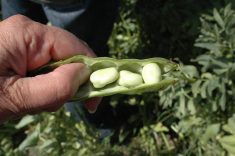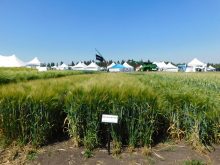Three-dimensional bin monitoring is one of the more talked-about new ag technologies.
Proponents of this type of grain monitoring — more formally called three-dimensional electromagnetic imaging or 3D EMI — claim it can spot potential trouble anywhere in the bin and alert producers before grain even begins to spoil. There’s also a safety factor out of reach of other monitoring systems, such as eliminating the need to ever climb on or inside the bin.
But is 3D EMI tech for you? Is it cost effective compared to traditional options such as cable-based monitoring systems?
Read Also

New crop insurer policy enables easier startup for faba beans
Agriculture Financial Services Corporation updated its normals for faba beans, which may open the door for more Canadian producers to feel comfortable growing the pulse crop in the future.
That’s a difficult question to answer given the technology is new and not yet being produced on a mass scale, which tends to reduce prices.
One of the early entrants in this business — a company founded to commercialize technology developed at the University of Manitoba — was until recently charging nearly $8,000 per bin plus a bin fee of two to six cents per bushel. (The company, GrainViz, recently put a temporary halt on sales as it is in negotiations with a new, unnamed investor. It is planning a product relaunch in the fourth quarter of 2018.)
But even at that price, the technology is still a bargain compared to cable-based systems, said Boyd Koldingnes, the company’s vice-president of sales and marketing. The unit cost of just one three-sensor moisture cable can run into the hundreds of dollars, with farmers generally installing as many as they can to maximize coverage, he said.
“Traditional systems are based on the size of the bin and the number of cables. For us, we use the same number of sensors whether you have a 10,000-bushel bin or a 300,000-bushel bin,” said Koldingnes. “It makes it very economical for somebody with a 500,000-bushel bin.
“We’ve heard of producers hanging as many as 40 cables per bin. You can imagine — just by the cost of the cables alone — that far exceeds $8,000.”
Based on health tech
The 3D EMI technique behind the GrainViz system was originally designed to detect breast cancer tumours. U of Manitoba engineering professors, Jitendra Paliwal and Joe LoVetri identified the potential of the technology for grain imaging but knew it would have to be modified. The modified system creates a 3D profile, which shows pockets of moisture which can overheat and spoil the grain.
It uses 24 radio antennae mounted to the bin’s inside wall which broadcast radio signals through the grain and send back information to the receiver antennae, GrainViz engineer Braden Pierce recently told the Western Producer. Each antenna takes a turn emitting radio waves, with the other 23 acting as a receiver, creating “a very complex moisture map,” he said.
The resulting top-to-bottom, wall-to-wall 3D image is better at detecting trouble spots, said Koldingnes.
“We’ve heard from a lot of producers who’ve emptied their bins and discovered huge spoilage area between cables,” he said. “Cable systems only see three to five per cent of the bin while our technology sees every bushel and can identify a potential problem area before it develops into a hot spot.
“Plus with our customer portal you can log in and see every bushel and its position within the bin.”
That’s also safer than having to climb up on top of a bin, open it, do a “sniff test,” and use a length of rebar to take a sample of grain. Even cable monitoring systems require some climbing and opening. However, because 3D monitoring offers a virtual model of the entire bin, Koldingnes said it’s not necessary to ever have to physically monitor grain.
“It alleviates a lot of safety concerns,” he said.
Before the company temporarily halted sales, the cost of a GrainViz system was $7,995, including a one-time setup fee regardless of bin size. On top of that was a two- to six-cent- (depending on bin capacity) per-bushel bin fee. This paid for a lifetime warranty on the GrainViz hardware and the software-based system which powers it, including all future updates. Features such as real-time moisture detection, insect detection, and worldwide remote control of bin fans were also paid through this fee.
“It’s the technology fee essentially,” says Koldingnes. “Because we are tech based, you are always provided with the latest technology and latest software advances. If we come out with a great new system, it will be like downloading any app on your iPhone or iPad. If you stay on our program for 10 years you’ll never have to purchase a new package again.”
The package also includes a private network independent of the user’s personal internet capacity.
“We don’t rely on any grain producers’ internet or cell coverage — we provide all of that. We don’t want to be a burden on anyone.”
















